

Thomas Wyatt. Thank you for choosing a Google eBook! - Google eBookstore. 18th Texas Cavalry, Company H. Walkelin de Ferrers. Robert de Ferrers, 2nd Earl of Derby. Robert II de Ferrers, 2nd Earl of Derby, a younger, but eldest surviving, son of Robert de Ferrers, 1st Earl of Derby and his wife Hawise, succeeded his father as Earl of Derby in 1139.
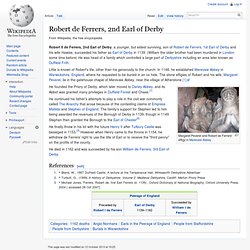
(William the older brother had been murdered in London some time before) He was head of a family which controlled a large part of Derbyshire including an area later known as Duffield Frith. Little is known of Robert's life, other than his generosity to the church. Henry de Ferrers. "Domesday records over 200 manors given to Henry de Ferrers"[1] Henry de Ferrers (also known as Henri de Ferrières) was a Norman soldier from a noble family who took part in the conquest of England and is believed to have fought at the Battle of Hastings of 1066 and, in consequence, was rewarded with much land in the subdued nation.
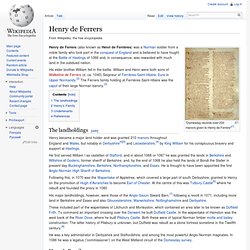
His elder brother William fell in the battle. William and Henri were both sons of Walkeline de Ferrers (d. ca. 1040) Seigneur of Ferrières-Saint-Hilaire, Eure in Upper Normandy.[2] The Ferrers family holding at Ferrières-Saint-Hilaire was the caput of their large Norman barony.[3] The landholdings[edit] Henry became a major land holder and was granted 210 manors throughout England and Wales, but notably in Derbyshire[4][5] and Leicestershire,[4] by King William for his conspicuous bravery and support at Hastings. These included part of the wapentakes of Litchurch and Morleyston, which contained an area later to be known as Duffield Frith. Henry's Family[edit] UNTITLED ENGLISH NOBILITY D-K. Untitled ENGLISH NOBILITY D - K v2.1 Updated 03 June 2011 Chapter 1.
DAMMARTIN . 3 Chapter 2. DOVER . 4 Chapter 3. Chapter 4. Chapter 5. A COMPLETE GUIDE TO HERALDRY by ARTHUR CHARLES FOX-DAVIES. The secret history of freemasonry. Naudon - The Secret History of Freemasonry - Its Origins and Connection to the Knights Templar _2. Greg Stafford - Pendragon Publications: Knights and Ladies, Volume I. Fulk III, Count of Anjou. Fulk III (972 – 21 June 1040), called Nerra (that is, le Noir, "the Black") after his death, was Count of Anjou from 21 July 987 to his death.

Life[edit] He was the son of Geoffrey Greymantle and Adele of Meaux.[1] He was less than seventeen years old when his father died and Fulk came to power.[2] Fulk had a violent but also pious temperament, was partial to acts of extreme cruelty as well as penitence. In his most notorious act, he allegedly had his first wife, Elisabeth of Vendôme (c.970 - 999), burned at the stake in her wedding dress, after he discovered her in adultery with a farmer in December 999. On the other hand, he made four pilgrimages to the Holy Land in 1002, 1008, and 1038 and, in 1007, built the great abbey at Beaulieu-lès-Loches. Chat. Battle of Hastings. Coordinates: The Battle of Hastings was fought on 14 October 1066 between the Norman-French army of Duke William II of Normandy and an English army under the Anglo-Saxon King Harold II, during the Norman conquest of England.

It took place approximately 7 miles (11 kilometres) north-west of Hastings, close to the present-day town of Battle, East Sussex, and was a decisive Norman victory. The background to the battle was the death of the childless King Edward the Confessor in January 1066, which set up a succession struggle between several claimants to his throne. Harold was crowned king shortly after Edward's death, but faced invasions by William, his own brother Tostig and the Norwegian King Harald Hardrada (Harold III of Norway). Hardrada and Tostig defeated a hastily gathered army of Englishmen at the Battle of Fulford on 20 September 1066, and were in turn defeated by Harold at the Battle of Stamford Bridge five days later.
Background Succession crisis in England. Guy of Lusignan. Biography[edit] Political rise[edit]
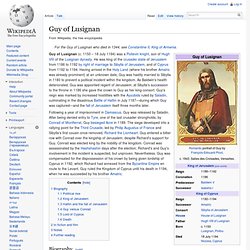
Siege of Acre (1189–1191) The Siege of Acre was one of the first confrontations of the Third Crusade, lasting from August 28, 1189 until July 12, 1191, and the first time in history that the King of Jerusalem was compelled to personally see to the defence of the Holy Land.[3] It was also the deadliest event of the whole period of the Crusades for the Christian ruling class of the east.[4] Nevertheless, it was a key victory for the Crusaders and a serious defeat for Saladin, who had hoped to destroy the whole of the Crusader kingdom.

In Tyre, Conrad of Montferrat had entrenched himself and had successfully resisted Saladin’s assault at the end of 1187. The sultan then turned his attention to other tasks, but then tried to negotiate the surrender of the city by treaty, as in mid-1188 the first reinforcements from Europe arrived at Tyre by sea. Under the terms of the treaty, Saladin would, among other things, release King Guy, whom he had captured at Hattin. But the victors scattered to plunder. Empress Matilda. Empress Matilda (c. 7 February 1102 – 10 September 1167), also known as the Empress Maude, was the claimant to the English throne during the civil war known as the Anarchy.
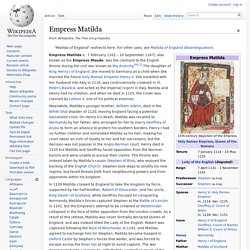
[nb 1] The daughter of King Henry I of England, she moved to Germany as a child when she married the future Holy Roman Emperor Henry V. She travelled with her husband into Italy in 1116, was controversially crowned in St. Peter's Basilica, and acted as the imperial regent in Italy. Ferrières-Saint-Hilaire. William de Ferrers. Our Family Tree: Pedigree: Henry Ferrers. Wiki: Ermengarde of Anjou. Henry Ferror. Fulk IV, Count of Anjou. Descendants - RoyaList Online. Biography of King William I (The Conqueror) - RoyaList Online.
Popularity - RoyaList Online. People - RoyaList Online. The Plantagenet Connection. Geoffroy (III), count of Gâtinais. A COMPLETE GUIDE TO HERALDRY by ARTHUR CHARLES FOX-DAVIES. Robert de Ferrers, 1st Earl of Derby. Robert I de Ferrers, 1st Earl of Derby (c. 1062 – 1139) was born in Derbyshire, England, a younger son of Henry de Ferrières and his wife Bertha Roberts (I'Aigle).

His father, born in Ferrières, Normandy, France accompanied William the Conqueror during his invasion of England. The family was rewarded with a grant of Tutbury Castle in Staffordshire and 114 manors in Derbyshire. Robert's elder brother William's main interests were in France. He joined Robert Curthose and was captured at Tinchebrai. His other brother Engenulf died shortly after his father and so Robert succeeded to the estates in 1088. From the beginning, he gave great support to Henry I.
William de Ferrers, 3rd Earl of Derby. William I de Ferrers, 3rd Earl of Derby (died 1190) was a 12th-century English Earl who resided in Tutbury Castle in Staffordshire and was head of a family which controlled a large part of Derbyshire known as Duffield Frith.

He was also a Knight Templar. William was the son of Robert de Ferrers, 2nd Earl of Derby and his wife, Margaret Peverel. He succeeded his father as Earl of Derby in 1162. William de Ferrers, 4th Earl of Derby. He adopted his father's allegiance to King Richard as the reigning king.
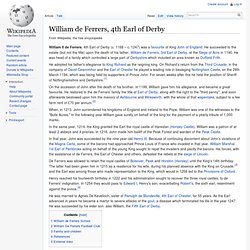
On Richard's return from the Third Crusade, in the company of David Ceannmhor and the Earl of Chester he played a leading role in besieging Nottingham Castle, on the 28th March 1194, which was being held by supporters of Prince John. For seven weeks after this he held the position of Sheriff of Nottinghamshire and Derbyshire.[1] On the accession of John after the death of his brother, in 1199, William gave him his allegiance, and became a great favourite. Bulla Aurea (Golden Bull) William de Ferrers, 5th Earl of Derby. Arms of William de Ferrers William III de Ferrers, 5th Earl of Derby (1193 – 28 March 1254) was an English nobleman and head of a family which controlled a large part of Derbyshire including an area known as Duffield Frith. He was born in Derbyshire, England, the son of William de Ferrers, 4th Earl of Derby and Agnes of Chester, a daughter of Hugh of Kevelioc, Earl of Chester and Bertrada de Montfort.
He succeeded to the title in 1247, on the death of his father and, after doing homage to King Henry III, he had livery of Chartley Castle and other lands of his mother's inheritance. He had accompanied King Henry to France in 1230 and sat in parliament in London in the same year. Like his father, he suffered from gout from youth, and always traveled in a litter. William de Ferrers is buried at Merevale Abbey, Warwickshire, England.
Family and children[edit] File:Effigy of Wm Ferrers, 5th earl of Derby-Merevale Abbey.jpg. Harold dead bayeux tapestry.png - Wikipedia, the free encyclopedia. Klamath ferrier shoes horse named Jim. Dirty Jobs - Ferrier. Bertrade de Montfort. Bertrade de Montfort (c. 1070 – 14 February 1117) was the daughter of Simon I de Montfort and Agnes, Countess of Evreux. Her brother was Amaury de Montfort. According to the chronicler John of Marmoutier: The lecherous Fulk then fell passionately in love with the sister of Amaury de Montfort, whom no good man ever praised save for her beauty. Bertrade and Fulk were married, and they became the parents of a son, Fulk, but in 1092 Bertrade left her husband and took up with King Philip I of France.
Philip married her on 15 May 1092, despite the fact that they both had spouses living. Children[edit] Matilda of Scotland. Matilda of England. Fulk V of Anjou and Jeruslaem. Eremburge de la Flèche. Heiress of Maine and Château-du-Loir, died 1126. Heiress of Maine through her father Helias de la Flèche and of Château-du-Loir through her mother Mathilde de Château-du-Loir, her large holding passed to the Angevin dynasty upon her marriage to Foulques V of Anjou.
Date of Birth: Unknown.Place of Birth: Unknown. Date of Death: 1126.Two Angevin chronicles give the year as 1126 [Chr. S. Albini Andegav., Chr. Ermengarde, Countess of Maine. Berkshire History: Biographies: Empress Matilda (1101-1169) Geoffrey of Anjou. Search. Wiki: Fulk III, Count of Anjou. Wiki: Ermengarde of Anjou, Duchess of Burgundy. Wiki: Fulk IV, Count of Anjou. Farrar. Back to: Genealogy index PoetsVisions 134596992. IV Foulques, Count of Anjou, born 1043; died 1109. He married 134596993. Bertrade De Montfort. 134596993. Bertrade De Montfort, born 1059; died 1117. Henry de Ferrers. William and Henri de Ferrierers were at the Battle of Hastings and were said to have brought many companies to the action. Ancestry of William Farrar: Alexander II, King of Scots. Wow you do have a lot of information on the family. You have the same style as my cozen Clyde Barnett.